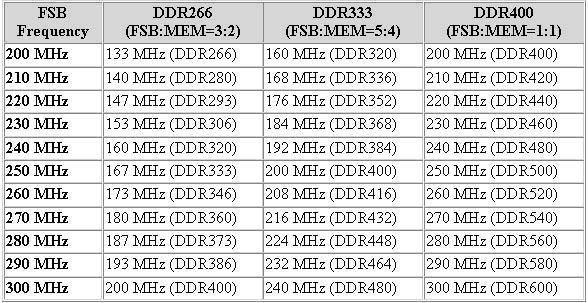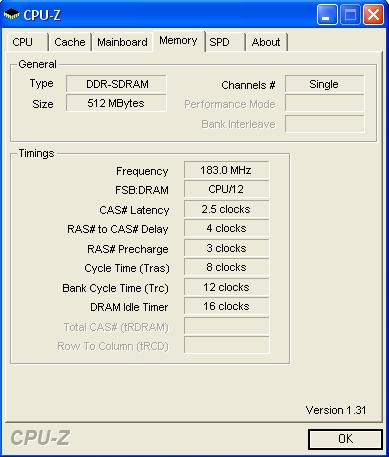AMD K8 Overclocking Guide |
|
|
Author: Lenin22
Date: 2006-04-12 20:17:46
|
|
Overclocking example
Ok, let’s look at a sample overclock. I’ve overclocked my Sempron to 2200MHz. The multiplier hasn’t been changed. The FSB has been raised to 275MHz. Logically, you’d thing the HT multiplier is still 4x. However it is a rule that having HT Frequency higher than default brings instability, so I lowered the multiplier to 2x, just to be safe. Lowering the HT multiplier even at 200FSB doesn’t affect performance one bit.By default, then my memory would be at 275MHz as well. However, I’m using Corsair Value Select PC3200. As some of you may know, it doesn’t overclock well, if at all. So I set a divider. A divider is a ratio between the memory speed and FSB. As we already know, by default the memory to FSB ratio is 1:1. Since my memory can’t handle 275MHz, I had to set an async divider. Here are some dividers:


Those are the most popular dividers in all motherboards. I set the DDR266 divider. My RAM is now at 183MHz since 275MHz x 2/3 = 183MHz. There isn’t any performance hit with my RAM under even default because of the high clock speed. PC3200 has a true frequency of 200 MHz. But it is doubled to 400 MHz due to DDR. The standard is PC3200. This means it has a peak rate of 3200 MB/s and runs at 200 MHz.
If your RAM does overclock, you just have to adjust its timings and voltage in order to reach the FSB on a 1:1 ratio. Tweaking RAM will be an upcoming article. This isn’t the last thing I had to do to end up with my nice overclock. Voltages are critical to maintain stability.
Voltages
The default voltage for the 90nm CPUs is 1.4V. To maintain an overclock you often need to raise the voltage. They key is to set as low a voltage as possible, yet maintain absolute stability. Raising voltage increases temperature. You must make sure your 90nm CPU doesn’t go far beyond 50°C at maximum load. There may be a need for additional/ aftermarket cooling, but for moderate overclocks, the stock cooling will do. There is usually a temperature monitoring program included with your motherboard. I only raised my voltage 0.04V, so my temperature didn’t go up too much.The temperature readings are usually off a few degrees compared to a diode attached to the CPU. Most newer motherboards can keep the difference of error within 2-3 degrees Celsius.
Stability Testing
Now you have to test the stability of your overclock. I use several programs to test my overclock. The first is 3DMark. I run both the 05 and 06 versions. If I pass without any artifacts (errors on the screen), I move on to SuperPi. There I run the 32M test which usually takes 30 minutes on average. If you have a dual core CPU, you must run two instances of SuperPi simultaneously. Once I pass that, I move on to Stress Prime 2004, a version of Prime95. This ferociously stresses both CPU and RAM. Again you have to run two instances if you own a dual core CPU. This program should run for at least 10 hours to guarantee “100%” stability.Conclusion
So those are the basics of overclocking. Remember if you don’t overclock you are missing free performance. Overclocking is a great method to get a free performance boost. If you don’t overclock, you’re missing out on free fps.
Apr 26th, 2024 05:06 EDT
change timezone
Latest GPU Drivers
New Forum Posts
- What are you playing? (20532)
- Horizontal black lines popping up on my screen? (7)
- What's your latest tech purchase? (20343)
- TPU's Nostalgic Hardware Club (18471)
- Which new games will you be buying? (320)
- Alphacool CORE 1 CPU block - bulging with danger of splitting? (21)
- Best SSD for system drive (82)
- What phone you use as your daily driver? And, a discussion of them. (1484)
- AMD RX 7000 series GPU Owners' Club (1087)
- im new to throttelstop and i think i messed it up by copying others any hints would be very much aprreciated (3)
Popular Reviews
- HYTE THICC Q60 240 mm AIO Review
- Alienware Pro Wireless Gaming Keyboard Review
- MOONDROP x Crinacle DUSK In-Ear Monitors Review - The Last 5%
- Upcoming Hardware Launches 2023 (Updated Feb 2024)
- Thermalright Phantom Spirit 120 EVO Review
- NVIDIA RTX 4090: 450 W vs 600 W 12VHPWR - Is there any notable performance difference?
- RTX 4090 & 53 Games: Ryzen 7 5800X vs Ryzen 7 5800X3D Review
- ASUS Radeon RX 7900 GRE TUF OC Review
- RTX 4090 & 53 Games: Core i9-13900K vs Ryzen 7 5800X3D Review
- RTX 4090 & 53 Games: Core i9-13900K E-Cores Enabled vs Disabled Review
Controversial News Posts
- Windows 11 Now Officially Adware as Microsoft Embeds Ads in the Start Menu (122)
- Sony PlayStation 5 Pro Specifications Confirmed, Console Arrives Before Holidays (117)
- NVIDIA Points Intel Raptor Lake CPU Users to Get Help from Intel Amid System Instability Issues (106)
- AMD "Strix Halo" Zen 5 Mobile Processor Pictured: Chiplet-based, Uses 256-bit LPDDR5X (101)
- US Government Wants Nuclear Plants to Offload AI Data Center Expansion (98)
- AMD's RDNA 4 GPUs Could Stick with 18 Gbps GDDR6 Memory (89)
- Developers of Outpost Infinity Siege Recommend Underclocking i9-13900K and i9-14900K for Stability on Machines with RTX 4090 (85)
- Windows 10 Security Updates to Cost $61 After 2025, $427 by 2028 (84)